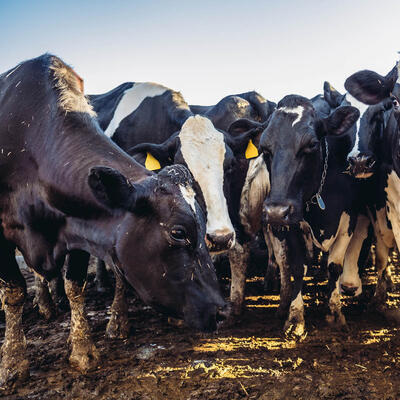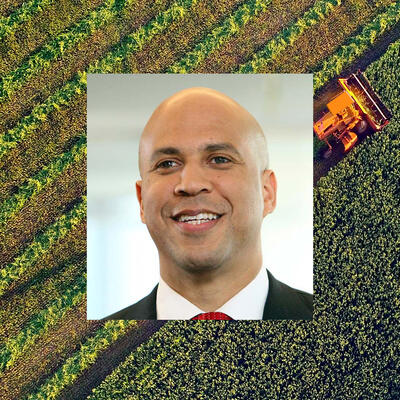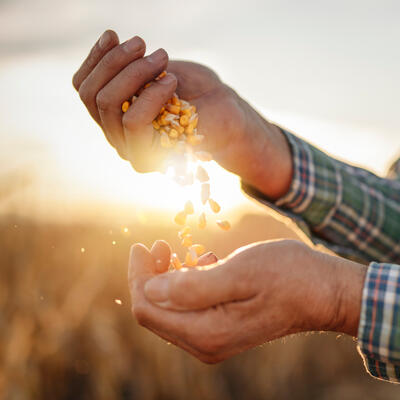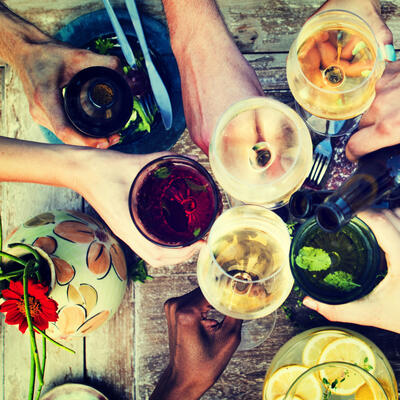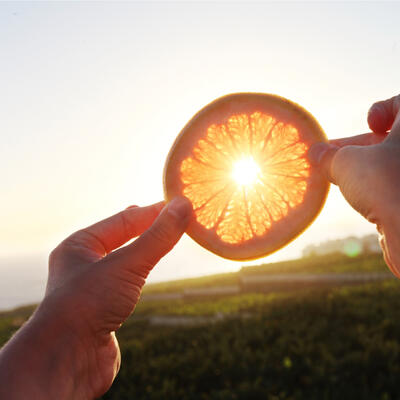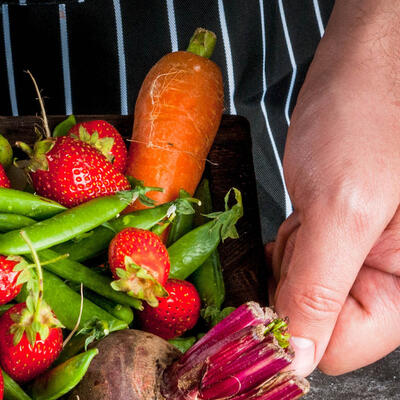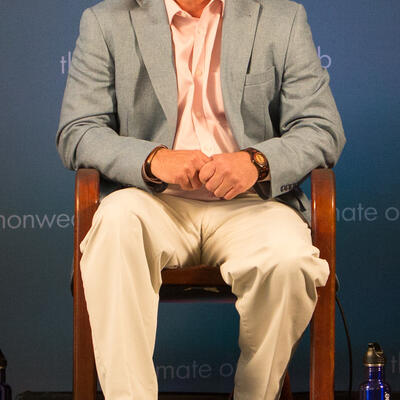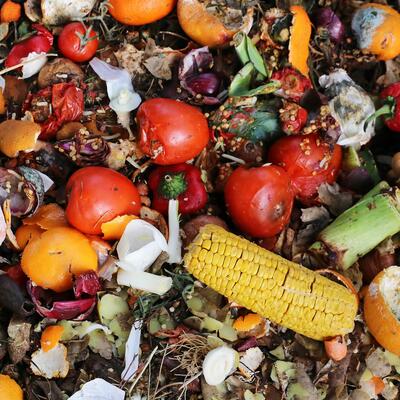
You Gonna Finish That? Saving Good Food from Going Bad
Guests
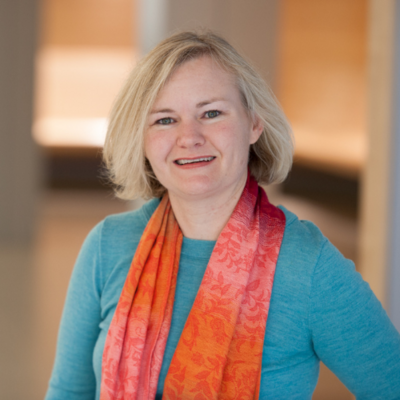
Dawn King
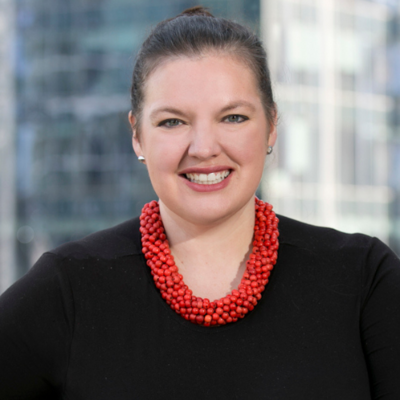
Lisa Moon

Norma Alonso

James Leyson
Summary
Globally, one-third of food produced every year is wasted. That’s enough to feed about 2 billion people — twice the number of people who are undernourished. In the developing world, most of the waste happens before the food ever reaches the consumers. It rots along broken supply chains or because of insufficient refrigeration. In rich countries, people and distributors tend to buy more than they need and throw it away when it spoils or passes expiration dates — a faulty system of quality control that, with the exception of baby formula, is not formally regulated.
“We even have expiration dates on things like salt, for crying out loud, which is literally a mineral, right? That is something that's never going to expire,” says Dawn King, a senior lecturer at Brown University who studies the economics of food, labor and climate change.
At the same time, the global food system accounts for a whopping one-third of the world’s greenhouse gas emissions. These two problems — waste and emissions — are intricately linked: Climate disruption exacerbates food insecurity. And industrial food production contributes to the climate crisis.
”One in four people right now are facing food insecurity,” says Lisa Moon, CEO of the Global Food Banking Network.
“ We have got to figure out how to waste less food because we're already putting in all the resources, all of the water, all the land resources, labor resources to grow this food. And then you have a third of it being thrown away.” Her organization helps make connections between food producers and food banks in more than 50 countries, getting good food to those who need it before it spoils on the field or in a produce stall.
Here in the U.S., twenty-seven states, including California and Texas, participate in the U.S. Department of Agriculture’s “Farm to Food Bank” program, which operates in a similar fashion. That’s important because farmers need help saving food that’s not pretty enough to meet grocery store standards, says King. Produce that isn’t picture perfect is classified as “B” grade.
Many countries in the European Union are taking a proactive approach to waste less food, says King. “So you'll see a lot more grocery stores who take B grade produce or produce that's still good, but probably won't be good in a day or two…and using it behind the counter to make smoothies, to make juices, to make prepared meals.”
And technology is playing a role, too.
“One of the most exciting innovations that we've seen, and it makes sense not just from an environmental angle, but also an efficiency angle and a cost angle, is what we call virtual food banking,” says Moon, in the form of an app that connects food suppliers, retailers or manufacturer with hospitals, orphanages or other charities to share their surplus.
“You use less emissions to recover that food. You could recover product that has a shorter shelf life because it happens much more quickly. And then you also can service areas that are far more remote than many times you would be able to reach from where food banks have traditionally been based in a country.”
This episode also features a news story produced by Harvest Public Media contributor Peter Medlin, a reporter with WNIJ Northern Public Radio.
Episode Highlights
01:50 – Dawn King on where waste happens in the food life cycle
07:00 – Emission from wasted food
10:00 – The problems with expiration dates
12:00 – Pros and cons of home composting
17:00 – Why US is struggling to meet its own food waste reduction goals
24:00 – Proactive solutions happening in the EU
26:00 – Farm to Food Bank story by Peter Medlin
30:30 – Norma Alonso of ABACO
33:00 – Lisa Moon on global food waste challenges
36:00 – How food banks can help rescue food from being wasted
41:00 – Solutions like trading among small scale growers in Africa
43:30 – New tech solution to match food producers with charities
48:00 – James Leyson at a market in Thailand
What Can I Do?
Resources From This Episode (4)
Full Transcript
Note: Transcripts are generated using a combination of automated software and human transcribers and may contain errors. Please check the actual audio before quoting it.
Greg Dalton: I’m Greg Dalton.
Ariana Brocious: I’m Ariana Brocious.
Greg Dalton: And this is Climate One. We’ve talked about the climate reasons to eat a more plant-centered diet, but today, we’re focusing on the food that doesn’t make it to your plate.
Ariana Brocious: Yep, wasted food. And it’s a lot more than that slimy bag of lettuce in your crisper drawer. While we as individuals do contribute to the problem, there’s actually a lot of waste at every point in the process – from the farm to our table.
Greg Dalton: And this is a GLOBAL issue, happening in every country. Food and agriculture is a huge climate lever. All the water, fertilizer, and energy used to grow food contributes to emissions. And then… a third of that food is wasted – much of it before it ever reaches a kitchen table. That’s just staggering.
Ariana Brocious: A third is a lot. That feels doubly painful when you consider how much of the world’s population is food insecure.
Greg Dalton: And of course we’ve seen how hunger has been weaponized in Gaza and ignored by the international community in Sudan, which has been suffering from widespread famine.
Ariana Brocious: So today we’re going to talk about some of these larger systemic factors that drive food waste AND about some of the solutions already underway. For example, a leader in this space is South Korea, which banned food from landfills nearly 20 years ago. Now most of their food waste gets converted to fertilizer, fuel and animal feed.
Greg Dalton: That’s really interesting - the circular model in action. And later in the show, we’ll hear about other food rescue efforts happening around the world.
Ariana Brocious: But we’re going to start things off here in the US. I spoke with Dawn King, a senior lecturer at Brown University who studies how the economics of food and labor leaves good food on the ground or in the garbage can. She walked me through the food life cycle.
[music change]
Dawn King: In the U.S., we see a lot of food waste actually in the supply chain. Two-thirds of our food is actually lost before it hits you or me. About 16 percent of total wasted food loss is at the farm level, before it even gets to a truck, right? Before it even gets to a grocery store.
Ariana Brocious: Why is that? Why is it wasted on the farm?
Dawn King: I always like to say free food is not free. Farmers have to face a lot of different challenges. One of those is the aesthetics of the food itself. So primarily, I'm talking, when we're talking about on farm, we're talking about produce, right? And grocers and those of us who buy food want our apples to look exactly one way. We want our zucchinis to look exactly one way. And so when they don't look that way, they're automatically characterized as B grade produce, which can dramatically impact the value of that produce. And so sometimes farmers will just leave misshapen produce on the field because it's honestly not worth it to them to pick it. They have to pay people to pick that produce. They have to pay people to put it into a box. They have to pay somebody or some organization to pick it up and ship it in a refrigerator truck oftentimes. And that costs the farmer money. So oftentimes that's why we see a lot of wasted food at that, that farm level.
Ariana Brocious: Elsewhere in this episode we hear about the farm to food bank program which is expanding…Are there other initiatives like that that help farmers capture some of that, free, not free food and make good use of it?
Dawn King: Absolutely. So you just mentioned one, which is farm straight to food banks. There are sometimes gleaning programs that will come in. So volunteers will come in and in coordination with the farms, pick that B grade produce. So it helps with that, those labor costs to get volunteers on the farm to help with that. Now that could also cause its own issues if the volunteers don't know where to step, but they don't know what they're doing. So that takes a lot of coordination in and of itself. There's also the issue, a big issue, quite honestly, are tax breaks. for food donations. This is not something guaranteed by the federal government. And so there are a lot of people who are advocating minimally for a tax break, which would be, you know, a certain percentage of the value of that food when farmers donate that food. And same with grocery stores.
Ariana Brocious: Okay, so we talked about the farm. So the next step is transportation, right?
Dawn King: Correct.
Ariana Brocious: So where is there loss there?
Dawn King: Yeah, transportation can provide its own form of challenges, especially when we're talking about produce. Like I just mentioned that oftentimes we need a refrigerated vehicle, right? To get food from point A to point B, especially any perishable food. So with the handling of dairy or produce or eggs or meats, what can happen is that it can go bad if it's not got if we can't get it into a refrigerated truck in enough time. Sometimes this actually also happens on farm just after harvesting, getting it into a cold place, we could lose some.
Ariana Brocious: I would imagine that the refrigeration challenge, keeping things cold over long distances, will only become more challenging as we see warmer temperatures.
Dawn King: Sure. Also some of it is very fragile. So I always think of like strawberries or berries, for example, that you really have to stack them appropriately. And if you don't, and one box kind of gets onto some strawberries, you're going to ruin those strawberries. And you know, as they say, one bad apple ruins the batch. It's the same with lots of produce. One goes bad and it can actually cause the rest to go bad. And it's a very, very quick turnaround time where the farmers pick something like strawberries till it gets to a truck before it gets to the grocery store. We're talking about days oftentimes, especially if it's not sprayed, a lot can go bad just in transportation.
Ariana Brocious: Okay. And then it gets to the grocery store. And from my understanding, grocery stores are actually pretty good about not wasting. But maybe then we have some loss there. And then there's the consumer end, right?
Dawn King: Correct. So at the grocery level, you're absolutely right. There's only about a one, 2 percent profit margin for grocery stores. So they have every incentive to keep and sell all the food that they have. When there is food at the end of the day, that's looking a little bad, or you know, maybe its past its expiration date, which is kind of a whole other reason why grocery stores will get rid of food, oftentimes perfectly good food. So not necessarily the perishable things I was talking about but things in cans, things in boxes, grocery stores will not sell those after the expiration date. So oftentimes those can go straight into the garbage, many times instead of being donated. And then you also have produce, which just like in transportation goes bad pretty quickly. So they have to pull that produce and get rid of it. So they do have every incentive not to waste food. but at the same time, certainly there's, there's food that goes to waste at the grocery store level as well.
Ariana Brocious: I was surprised to learn that wasted food, if it were a country, would be the third largest source of greenhouse gas emissions in the world, according to the UN's Food and Agriculture Organization. So, speaking about trucks and transport, where are the emissions coming from?
Dawn King: So depending on what stats you're looking at is where the emissions come from. So you're absolutely right. Estimates are between one quarter and one third of total greenhouse gasses globally come from food production, right? So that's that entire cycle of food production. if we're looking at the global scale, quite honestly, a lot of that has to do with deforestation in order for us to plant the plants or to graze the cattle, places like Brazil and Indonesia. If we zoom in a little bit to the United States where deforestation isn't a huge part of that, we need to look first at the inputs that we put into growing food and nitrogen fertilizer is way, way, way more potent than carbon dioxide or even methane, up to 100 times more potent and so what we put the nitrogen fertilizer nitrous oxide, that's what we spray to fertilize plants. Some of it's absorbed by the plants. Some of it seeps into the air, right? Where it's a greenhouse gas. Some of it seeps into our soil, which then gets into waterways, which causes all sorts of other problems. And as we mentioned, there's also the wasted food component that goes into that.
Ariana Brocious: Right. Because wasted food, when it rots, also releases methane, which is another greenhouse gas.
Dawn King: Correct. 25 times more potent than carbon dioxide.
Ariana Brocious: When we spoke earlier, you said you have an issue with the term food waste, Can you explain why?
Dawn King: Sure. So I always try to say wasted food. Instead of food waste, because when we talk about food waste, the first thing we think about is kind of slimy garbage that rats are digging into. It smells. It's putrid, right? That's food waste. It's gross. Nobody wants to touch it. I instead much prefer to use the term wasted food because that's actually what we're talking about. Oftentimes, perfectly edible food that goes to waste when there are people who are hungry, we want to get that food to them. So I always like to use the term wasted food instead of food waste.
Ariana Brocious: I love that. That's a much more appealing framing, as you say. So you mentioned that expiration dates can be another problematic part of this equation, because they drive food waste, both on the consumer side and at the grocery level, where we, you know, have this sense that food is bad and needs to be discarded when in fact that's poorly regulated, if at all, right? So can you explain how that system works and how we could improve it?
Dawn King: So if you ask a room of a hundred people, have you ever thrown away food from your pantry because it's past its expiration date. Almost all of us are going to raise their hands, most likely, myself included. This is something that we assume as consumers. Well, there's the expiration date and the federal government sets those regulations. But there are actually zero federal regulations for expiration dates, except for baby formula. That is the one product where there is a federally mandated expiration date. So we oftentimes assume that our food is bad when it's not bad at all. And in fact, those who decide when, when and where to put that expiration date are actually the food manufacturers themselves. What they're guaranteeing with that expiration date is that food will hold its best quality up until that date. But we interpret that as the food being bad and that's not necessarily the case at all. And we even have expiration dates on things like salt for crying out loud, which is literally a mineral, right? That is something that's never going to expire. So the European Union's done a little better on this policy-wise by trying to rein in expiration dates, which is a pretty simple policy goal that would lead to a lot less food reduction, especially at the grocery store and household level.
Ariana Brocious: I think part of this can stem from systems from a long time ago when maybe canning was less safe than it is today. Or I was reading an article recently about how rice way, way back, uh, you know, when it was milled, it had all kinds of things in it, that's why we are supposed to rinse rice is because it would have things that could spoil. Now, in fact, most rice is done in an anaerobic environment, you know, packaged. So it's very, very shelf stable for a very long time. Same with like beans and things like that. So, the average American wastes roughly a quarter of the food they purchase. And a lot of this waste, in addition to things like you mentioned from the pantry, is stuff that gets lost in your refrigerator and you forget and it spoils, right?
We've talked about composting on the show before, and we know that that's important, but doing it at home can have complexities, especially when you're talking about scale, right? How much do you advocate for composting as a, as a partial solution to this?
Dawn King: Composting certainly is a partial solution to this and and mostly the wonderful thing about composting is you're taking something that would have been waste and you're turning into something that's going to feed the fields, right? It's soil. It's a fertile soil, and you're not using that nitrogen oxide and the chemical fertilizers. So that's really what's wonderful about composting. But once we get to the household level, and I will even say community garden level, it becomes a lot more complicated. If you're throwing away food scraps, um, you could very much attract rodents, right? This happens all of the time. You really have to tend to that food, the food scraps, the food waste. There is a ratio of what you want. Green matter to brown matter, right? The green matter is all the sloppy stuff, the food waste. Brown matter, things like leaves, dried leaves and stuff like that. So you need the perfect mixture of those to create a good working compost that's not going to smell, you need to aerate it, pretty regularly. So that's labor involved, but mostly at the household level, many of us don't have a backyard, right? Many of us live in, you know, apartment complexes and things of that nature, where there's really not even the space to compost. Nor do you, if you don't have a garden in the back, why would you want to create compost, right? So it absolutely is a huge part of the solution, but it's really difficult at the household level. There are some municipalities, San Francisco being the number one that does curbside compost pickups. So that by far is the easiest way for us and residential composters to get our food scraps to a composting system. But it's also really expensive, really, really expensive at the municipal level to do household pickups.
Ariana Brocious: Right. It's complex because you need it to be at scale to really have an impact, but then that costs money. And that's actually being rolled out across the state of California, that composting requirement. So even before food goes to a compost bin, let's say, there are things that an individual can do to extend the life of their perishables. What solutions or suggestions do you have for someone to just minimize some of their own waste at home?
Dawn King: Sure, I think number one is before you even get home. It's what you're purchasing at the grocery store, so making sure you're not over purchasing. First of all, it's great because it will save you money. But there are a lot of things you could do in a quick online search can tell you the best ways to store that. You know, do I store it in the fridge? Do I store it outside of the fridge? Those types of just simple storage. So, you know, some produce, if you cut it up and put it in water in the fridge, it's gonna last a lot longer., sometimes just wrapping up the, you know, the ends of things like bananas, that could actually, uh, make them ripen a little bit less quickly. So those things can help. and I'll put my food scraps, especially when I'm peeling things and stuff like it, put them in a bag, put it in the freezer. They're not going to smell, they're not going to get all slimy and gross. And then when I want to make a stock, I just do it. dump it all in, in water and boil it for a long time. You could also use bones and things like that. And some people will can, some people will pickle, uh, to preserve, especially if you're growing things in your garden, tomatoes are kind of the number one thing you have zero tomatoes. And then you have. You know, 100, 200 tomatoes all of a sudden, two weeks. So learning how to make sauces and salsas and canning those types of products really helps preserve food on that level as well.
Greg Dalton: We’re going to take a quick break. And when we come back, we’ll hear more about how countries in the European Union are trying to ensure all food gets eaten.
Dawn King: You'll see a lot more grocery stores who take B grade produce or produce that's still good, and using it behind the counter to make smoothies, to make juices.
Greg Dalton: That’s up next, when Climate One continues.
Ariana Brocious: Please help us get people talking more about climate by sharing this episode with a friend. And we’d love to know what you think of the show. Please give us a rating or review. You can do it right now on your device – and it really helps people find the show. Thanks!
This is Climate One. I’m Ariana Brocious. Let’s get back to my conversation with Dawn King of Brown University – she studies food policy, climate change and agriculture. The USDA and EPA have a goal to reduce food loss and waste by 2030. But King says we’re not very close to reaching that goal.
Dawn King: One of the issues is that wasted food is handled almost entirely by municipalities, right, especially at that consumer level, when people are actually throwing things away that go eventually to the landfill, those are tons of, you know, thousands and thousands and thousands of towns and municipalities. We haven't seen much from the federal level trying to get rid of our amount of wasted food. One thing that they could do is really extend and make permanent something like a tax credit for food donations. Another thing that they could do, is educate us and farmers and especially grocery store managers about something like the Bill Emerson Good Samaritan Act. So oftentimes, people are afraid to donate food, whether you're at an institution, maybe like at a college or something with a lot of extra catered food, and everybody's afraid to donate in case somebody gets sick, right? I don't want to donate the food because I don't want to get sued. But there has never been a single case of being sued for food donation in the United States. And one of those reasons is that that policy is there at the federal level, but we really have to let that be known to those who otherwise might be donating their foods that are currently really scared, that it's never happened in the history of the United States where somebody has successfully sued for food donation.
Ariana Brocious: That's good to know. We talked a little about the complications and costs of transporting food, especially long distances, in refrigerated trucks. This makes me think that there's an argument to be made for eating more close to home, but I understand that from a climate lens, that doesn't actually matter that much, so maybe it's more about food waste. Or is there an argument here to be made that you should try to eat close to home to avoid some of the wasted food problem?
Dawn King: Yes and no. It is a little bit complicated. So one thing I always say, oftentimes if you're eating local food, and that usually means maybe a smaller farm, there's a much larger percentage that they're using more sustainable farming practices. It doesn't necessarily mean they're always going to be organic or they're not using chemical pesticides and fertilizers, but oftentimes they're using a lot less, even if they are using them. So that in and of itself could be a reason to eat and, and purchase more locally. There's also what we call food miles, right? That's received a lot of attention but that's where it becomes a little complicated. A big cargo ship, maybe, you know, carrying produce from Chile to the United States, that is a lot of miles traveled, right? The average bite of food could take, you know, two to three thousand miles before it gets to your mouth. And that seems crazy. But what folks aren't thinking about is that a cargo ship is an incredibly efficient way to transport items per pound, right? Or maybe per apple, let's say. As opposed to me getting into my car, driving, let's say five miles or so to a farmer's market, picking up some produce, but I'm certainly not getting all of my groceries. I can't find them all at a farmer's market. So I take that one bag of produce and put it in my passenger seat in my single person vehicle and then drive five miles back home. And so once you start comparing those two things, it becomes a little more fuzzy where if you're talking about per item of produce or per apple or per tomato, there actually could be less greenhouse gasses per item that are traveling from really, really far away. So it's all about the efficiency of travel when it comes to food miles. But I always do say it is good if you can, and if you could afford it, which is the other part of purchasing local food to purchase local, but it does tend to be a little more expensive. So from a food access perspective, it's perfectly fine to go to your grocery store, your local box store for food.
Ariana Brocious: Okay. McDonald's, Mondelez, JBS, the world's largest meat producer, once made bold net zero pledges, but now they're backsliding, citing growth. And with that growth, their emissions are increasing in areas like water and waste. So these are huge corporations. Is there a mechanism that can help hold these big wasters accountable?
Dawn King: It's really tough when we talk about regulatory policy in farms, especially with climate change, and that is because farms have historically not been included at all in our climate change policies. We talk about fossil fuels, we talk about electricity, right? We talk about cars and transportation, but what is not currently regulated are on farm emissions. Now, if you're a farmer, you prefer it that way, right? Nobody wants to be regulated. So it becomes very difficult. There is a very strong farm lobby in the United States, uh, that just doesn't want to be regulated. And what we're forced to cut out quote unquote hope for is that they're doing it out of the goodness of their heart, that we have to take them for their word on it. because there's really not anybody overseeing this.
Ariana Brocious: Wow. That is pretty striking when you consider how much agriculture contributes globally to emissions. So as I understand it, food waste hovers around 30 percent regardless of the wealth of a given country, which makes it sound like a pretty intractable problem. Are there countries that are leading the way in minimizing food waste or wasted food?
Dawn King: Sure. And there, there's a couple of differences when we talk about the United States or globally. So in the United States, we're just much more likely to throw away good food, right? Globally, at the, the individual level, the household level, there's actually less food waste than in the United States, but what we do see is there's much more in transportation and distribution for some of those reasons that you need a refrigerated truck. Not only do you need a refrigerated truck, you need a road, right? For that truck to travel on. And if the road really isn't accessible for certain parts of the season, uh, and things of that nature, it might be backcountry roads. It could be really difficult to get that. Food from point A to point B, especially, let's say, if you're trying to sell goat milk or something like that, that absolutely has to be refrigerated. We, globally, we could lose a lot in that arena. The European Union and many countries in the European Union are really trying to be proactive when it comes to wasted food. So you'll see a lot more grocery stores who take B grade produce or produce that's still good, but probably won't be good in a day or two and maybe they don't want to sell and using it behind the counter to make smoothies, to make juices, to make prepared meals that will go at, you know, a pasta salad or something like that, that will go out the next day. They tend to be a little bit better about donating food, although that's not always the case. The European Union has done things like gotten rid of expiration dates on things like salt and vinegar and other things that will, you know, basically last for years and years and years and years and years. And then I've also seen going to the hyper local, right. In small rural municipalities, we actually see that there's more communication between a grocery store owner and that one little maybe tiny food bank or food rescue, where I've also seen a lot of movement because everybody knows everybody else. And you just go talk to the grocery manager and he's cousins with that person. And, it's much easier to donate food. So sometimes we see these really cool connections at these small municipalities where they're just easy to connect everybody.
Ariana Brocious: Great. Well, that's encouraging. Dawn King is a Senior Lecturer in Environment and Society at Brown University. Thank you so much for joining us on Climate One.
Dawn King: Thank you so much for having me.
Greg Dalton: 160 billion pounds of food goes to waste every year in America… thrown away by kitchens, by grocery stores, and by farms. There’s a federally-funded effort to cut down on that waste by connecting local farmers and food pantries. The U-S Department of Agriculture’s “Farm to Food Bank” is in 27 states, including California and Texas. But as HARVEST PUBLIC MEDIA CONTRIBUTOR Peter Medlin reports… funding for the program depends on Congress and what gets included in the next farm bill.
Peter Medlin: In the production hall at the Northern Illinois Food Bank -- about an hour west of Chicago - , volunteers are packing up meals.
Jacob Lamplough is the food bank’s interim director of food procurement.
Over the past few years, the Northern Illinois Food Bank has been able to provide even more local produce to residents - 400-thousand pounds of food that otherwise would GO TO WASTE.
“The peaches are the big one, we've had apples, and then we've even had things like squash and a bunch of different peppers.”
Peter Medlin: It’s food farmers can’t sell to supermarkets because it has a blemish, is a weird shape or just not the right size. It’s good food, it tastes the same, but it often rots away on farms because there’s no market for them.
Nationwide… the Farm to Food Bank program has moved millions pounds of surplus food.
It was authorized through the 2018 farm bill. In the most recent round, the USDA handed out nearly $4 million to state agencies for Farm to Food Bank projects.
27 states are participating, including Illinois, California, Iowa, and Texas.
Stacy Dean — Deputy Under Secretary for the USDA’s Food & Nutrition Services — hopes to spark interest in MIDWESTERN FARMING states that AREN’T participating… such as Kansas, Nebraska and Oklahoma.
“I can’t speak to the why’s but, These are the bread baskets of our country. And if they're leaving food available, unharvested, that we can be using to feed vulnerable families, then let's work together to figure out a path forward.”
Peter Medlin: The Farm to Food Bank program is funded through the farm bill, which comes up for reauthorization every five years. Deans says LAST fall… funding briefly expired before the farm bill was extended for another year.
“Well I think Farm to Food Bank was particularly vulnerable.”
Peter Medlin: And funding in the next farm bill isn’t guaranteed. In Illinois… officials wanted stability for the program… so IN EARLY 2023 Governor J.B. Pritzker signed a law establishing state funding. That makes Illinois pretty unique among Farm to Food Bank states.
Raghela Scavuzzo is with the Illinois Farm Bureau. She says the state funding means the program will continue no matter what happens with the farm bill.
And she says that allows farmers to feel more stable… and diversify their products.
“So maybe we were afraid to grow broccoli, because we didn't know the market was there. What happens if we can't move all of that or it's just not as pretty? Now we've created the secondary market to recover some of those potential losses.”
Peter Medlin: While farmers aren’t paid full-price for the food… they’re able to cover their costs, including labor and transportation. And they don’t have to see their food go to waste.
“We had a farm last week that was going to get hit by the frost with apples. We moved almost 10,000 pounds of apples off of their trees. It covered their labor, but that product would have just had nowhere to go if it hadn't been for this project.”
Peter Medlin: Rendleman Orchards is one of more than a dozen farms participating in Illinois’ program.
Wayne Sirles is the owner and manager of the orchards in southern Illinois. He says, with the help of other local farms, they sent out about a dozen semi truck-loads of produce in 2022.
“It's a win-win situation, not just for the customers of the food bank, but also for the farmers themselves.”
Peter Medlin: Now he knows a vegetable or fruit with a blemish won’t get dumped. For Harvest Public Media, I’m Peter Medlin.
Greg Dalton: Coming up, we’ll hear about successful food rescue efforts outside the US. Like in Sub-Saharan Africa, where smallholder producers who grow one crop, trade their overabundance with their neighbors:
Lisa Moon: My household can only eat, so many tomatoes a year. What I, what you really need in that household is, you need a good diverse array of products. You need some squash, you need some carrots, you need some green beans, maybe some, you know, pumpkins and the like.
Greg Dalton: That’s up next, when Climate One continues.
This is Climate One. I’m Greg Dalton. We’ve heard a lot this episode about the problems of wasted food – but there are also many people working on solutions at many points along the chain. The Global Food Banking Network helps recover surplus food before it’s discarded and distributes it to those facing food insecurity.
Ariana Brocious: Norma Alonso is the cooperation manager of ABACO, the Colombian Food Banking Network. It’s a nongovernmental organization that has 25 food banks in as many cities throughout the country. She sent us this snapshot of their food rescue work.
Norma Alonso: 35 percent of the food produced in Colombia is lost and wasted. That means 9.7 million tons per year. And with this amount of food, we can feed Panama, Luxembourg, and Uruguay all together for a year. We have been running this program for 12 years so far, and we have rescued more than 49,000 tons of fruits and vegetables at the national level.
In this moment, I'm in the village of Morritos,which is an hour and 20 minutes from Medellin, It's a bit cloudy in this moment, and because of the rain, we are right here at the farm around midday.They call us because they are going to donate us 30 baskets of tomatoes. That is about 660 kilograms of product. These tomatoes were for the central market but were discarded because the tomatoes did not meet the size and the color demanded by the consumers in the market. But all of them still suitable for human consumption.
On this route today, I'm with Juan David and Juan Pablo, who are the food bank ambassadors. The ambassadors are very important for us, uh, because through them, we establish much closer relationships with the farmers, almost like a friendship. Cultivating this relationship is very important for us, and as a foodbanks, because the farmers are linked to the program by word of mouth. When we finish the loading the tomatoes onto the truck, we will visit another two farms that are scheduled for today and that will donate approximately 1.2 tons of carrots, cabbage and spinach. Last year, with the efforts of 20 food banks and 2,090 farmers, We were able to rescue 7,750 tons of fruits and vegetables. We know that it is still much to do, but every effort counts.
Greg Dalton: Colombia is just one part of the Global Food Banking Network. I spoke with President and CEO Lisa Moon about how she sees food waste showing up in other countries around the world. She explained that it looks different in different places.
Lisa Moon: Let's say you're based in the UK and you go to your grocery store and you're buying some green beans, and you want those green beans, of course, to be packaged exactly perfectly. You want them all to be the same length. But if you were to follow the story of that green bean back to where it was grown initially, it was. probably grown on a farm somewhere in northern Kenya and, when that green bean was grown and they started pulling it out of the field, there were certain cosmetic standards in place that, um, that meant that only about 50 percent of those beans ended up being exported to the UK to be sold in your grocery store. And so what happens to the other 50 percent of those green beans? For a lot of reasons, in part due to the law and legal and policy frameworks, and also due to the fact that we don't have a lot of partners that are focused on rescuing surplus food, most of the time those green beans are just dumped or discarded. But you know, I'm very fortunate to work with a group called the Global Food Banking Network and we're working with community based organizations across more than 50 countries that are partnering with those green bean growers to make sure those nutritious green beans that aren't eligible for export do in fact get to people in need.
Greg Dalton: So, there's a bit of our vanity because we like our beans to look a certain way and have a certain shape. And then there's some, uh, I guess flaws in the system that ends up with all those wasted green beans.So What happens in Kenya, where these green beans are grown when climate driven drought happens? How does climate change make this green bean problem worse?
Lisa Moon: Climate change, of course, is just wreaking havoc across the food system. And that's everywhere for eaters, people that, you know, um, that already have trouble accessing food when there's times of, of drought or extreme weather events. A lot of times that impacts the price of food available at their markets or grocery stores. But it is having such a significant impact on the food and agricultural production system. I mean, the IPCC has said that we could see production decline anywhere from 1 to 1.5 percent annually between now and 2050 if we don't make any changes related to how we grow our food. So it's really alarming that we have this major food insecurity problem, 2.4 billion people, one in four people right now who are facing food insecurity. And then you have a food production system. that is kind of at the whims of climate change. And so I think this is one of the reasons that I feel so passionately about the fact we have got to figure out how to waste less food because we're already putting in all the resources, all of the water, all the land resources, labor resources to grow this food. And then you have a third of it being thrown away.
Greg Dalton: Right. So that doesn't sound like a lot, but 1.5 percent year after year after year, that'll can see how that can add up and climate could make this work. So, so how does the Global Food Banking Network connect with farmers, food distributors? How are you going to address this green bean problem or, or any other commodity or, or food, uh, during stress on the system.
Lisa Moon: Yeah. So food banks really work at a local level. So within local and national food systems, and they really exist to be the partners of food producers. So they partner with farmers, manufacturers, um, uh, wholesalers, marketers, and retailers to help them identify where is their surplus food that they are discarding, but it could be saved. And then they provide them more or less a logistics service to move that food to people facing hunger. when you roll all of these grassroots level action up to the global level, it's really significant. Last year, more than 30 million people facing hunger accessed food through a local food bank, and the vast majority of that food was fruits and vegetables and highly perishable products. but we would really love to see that this model gets more attention, um, because it is a way to increase food access while not putting increased pressure on production agriculture. So I always like to use this example that I saw, um, on one of my first visits to see our partner in Bogota and, uh, they work a lot with retail sales. And stores and milk is obviously a commodity that is in high demand and stores often overpurchase it because, you know, they want to make sure that when a customer comes in and you know, they have kids, your kids need, they need their milk when they need it. And so it's important that you have a good supply on the store shelf. But that also means that there is waste with specifically within that product. And if you only have two days or so before that milk can be consumed, a lot of times you're dumping that because it won't be safe to eat within a long enough window to get it back to a person that needs it. But the Food Bank in Columbia works very quickly. They're able to pick up milk from, um, both producers and at the retail level. And within 24 to 48 hours, have that milk into child feeding programs, having it consumed still within that safe timeframe. So I think that what we're really seeing on the food recovery side, is that it's a great investment opportunity to be able to save food that, again, we've already put all the work into producing it. Let's just make sure it gets consumed.
Greg Dalton: Right. in energy, we often hear about oil rich countries that are also, you know, energy poor because all the oil goes exported to far away countries and they don't actually don't have the benefit of that resource Is there also true that where there's places that produce a lot of food that actually have hungry people nearby? And how are you trying to, to, to, you know, fill those gaps specifically? Is it you need more trucks? Is it you need, is it because the, the price isn't right or because there's regulations or corruption?
Lisa Moon: Regardless of what country you're looking at, if they are a food producing country, there's a significant amount of surplus likely going to waste. And then we do know that food insecurity is pretty much a global phenomenon and that it exists across the world, across communities, obviously at different levels of severity. So then it really does become, so why is all this food going to waste, Greg, just exactly like you're asking, and it's a couple of reasons. I think the first is that the policy environment really isn't set up to encourage donation of food. In most places, it is far easier, far cheaper, and far less risky to just throw food away, perfectly good food away, than it is to donate it to a food bank or any other organization. In most places, there is not liability protection for farmers or manufacturers or retailers that want to donate their product, even if they do so in good faith.
Greg Dalton: Right. We, we heard earlier this episode, we heard about the Good Samaritan laws in the U S that protects people. But you're saying that doesn't exist in other places. And that's, that's a obstacle to people saying, Oh, okay, we'll just sort of ditch it rather than risk, take some risk.
Lisa Moon: Yeah, absolutely. You know, the second thing too, is a lot of times there are taxes that discourage donation. You know, if you are wanting to donate food, And you still have to pay tax on that food as if you were selling it, right? Um, it's cheaper just to landfill it or discard it. Those fees are often much lower than the tax. And so, in many places, there's a tax disincentive, which just seems really egregious, kind of given, you know, how valuable food is in our world today and how many people need it.
Greg Dalton: Right. Yeah. Africa has the highest percentages of agricultural loss Uh, but there's been a huge growth of recovery there. What changed in Africa?
Lisa Moon: At least with the food banks that we work within Sub-Saharan Africa, all focus really on how do they partner well with farmers and um, I think partnerships with the commercial growers, they're growing for export markets. You know that food is heading for Europe or even the Americas or parts of Asia, right? There's a natural partnership there because about 50% usually of what's being grown is being discarded for all the cosmetic reasons that you and I have already talked about. Um, so that's a great source of product for food banks. But the other, I think, really exciting things about what's happening in agriculture in Africa is the incredible partnerships that, um, food banks are having with smallholder farmers. And this doesn't just happen in Africa, but it's a place where this has really been pioneered. And what we is that small scale growers, they're growing mainly for their households, right? And they're trying to get a bit of what they're growing, uh, to market. But what they really need is diversity of products. You know, if I'm a small scale grower in Northern Kenya, and I'm really focused on growing tomatoes, right? My household can only eat, so many tomatoes a year. what you really need in that household is, you need a good diverse array of products. You need some squash, you need some carrots, you need some green beans, maybe some, you know, pumpkins and the like. And so what we have seen food banks facilitating there is having smallholder farmers come together and sharing between themselves that are all growing different types of crops. So you can kind of grow the dietary diversity, um, of that household. And so the food bank there, sometimes they're providing the food, maybe through a barter system, they'll take your excess tomatoes. The food bank will provide cooking oil. But a lot of times that sharing is happening within that community, and so I think that's one of the most exciting things that we're seeing as we imagine. What does food sharing and food saving look like in Sub-Saharan Africa, in South Asia and Southeast Asia in the next 10 years and beyond?
Greg Dalton: Right. So that's actually food banks going upstream to change what's produced, not just sort of, you know, take what leftovers what's produced. And so are there lessons that farmers and distributors can learn from food banks and food recovery?
Lisa Moon: I think that, uh, the first thing is, is just how to donate surplus product in a way that is legal and without risk, right? I mean, farmers, already you have farming being one of the most difficult, difficult jobs in the world and incredibly risky. You're working on very thin margins, right? So, so I always think about that when we're talking with farmers as they are putting everything they have into, into growing, growing this food. And so if they have a partner that can come in and harvest what they know is not going to be saleable, take it off their hands, transport it to a different location, I mean, that for them is a win. The food is still grown. Obviously it gets eaten, it gets to where it needs to go, but they aren't taking on the extra labor of having to figure out, you know, what to do, how to harvest themselves and taking on the cost associated with that.
Greg Dalton: Right, right. There are some technological advancements that come into play here, where technology can kind of basically match demand with excess supply.
Lisa Moon: Yeah, one of the most exciting innovations that we've seen, and it makes sense not just from an environmental angle, but also an efficiency angle and a cost angle is what we call virtual food banking. So you have a food bank that has kind of identified suppliers, and it could be farmers, it could be retailers, in some case manufacturers, that have kind of regular surplus available, um, and it could be located anywhere around the country. And then the food bank vets agency, so these could be charities like child hunger charities, or maybe they're job training charities, um, could be orphanages, hospitals, et cetera, that really need food to do their work well, because they're engaging with low income populations and through technology through an app, they connect these, these parties. So if I'm a farmer in Northern Chile, for example, the Chilean food bank, they have their warehouse down in Santiago, but I'm, I'm able to say, you know, I've got a ton of X product and you can put it on the app and what the app will do then is it will alert three charities that could receive that product within driving distance from where the producer is. And so the matchmaking that a food bank would do in the past, primarily through using kind of trucks and warehouses and, um, kind of a more traditional hard asset supply chain, that matching occurs entirely virtually. Um, and that's great on so many fronts. You use less emissions to recover that food. You could recover product that has a shorter shelf life because it happens much more quickly. and then you also can service areas that are far more remote than, um, many times you would be able to reach from food, where food banks have traditionally been based in a country.
Greg Dalton: Right. Right. Do you know how food recovery is helping the climate? Is there any way to quantify that?
Lisa Moon: Yeah, well, we for sure take a look at, you know, when it comes to our food banking organizations, what they're recovering on an annual basis. and it's about the equivalent of taking 335,000 cars off the road annually. But I think, Greg, from our perspective, if we're looking at how much food is going to waste and what is being recovered today, it's less than 1 percent of all the food that's being lost or wasted. So if you think, what, what if we were able to even increase that from 1 to 5%? That would have an enormous impact, first of all, on providing food access to the one in four people that are going to bed without enough or the right kinds of food every day. And it also would mean a big win for the environment. Even from just a waste standpoint, you know, there is a significant amount of methane emissions that are coming from landfills and I think it's half of all emissions coming from landfills are, are organic waste related and most of that is food. So to tackle the methane challenge, there's really, you know, kind of three ways related to the food system to do that. There's rice, there's cows, and there's food loss and waste. And so we're not going to be able to see progress on the methane goals that have been set at recent climate COPs unless we are able to tackle the food loss and waste issue.
Greg Dalton: Right. It's a big lever. Of course, we know that, you know, methane is 80 times more harmful than carbon dioxide in the short term. So tackling food waste is not only feeding hungry people, uh, who has enough food for them somewhere in the world, as well as addressing the climate. So to wrap this up, what needs to happen to make food donation more accessible to food producers and distributors on a global scale?
Lisa Moon: I think first and foremost is, is just awareness about the incredible work these grassroot leaders are doing, um, you know, around, around the world. Um, no matter where you live, you probably live within the vicinity of a food bank and a food bank is happy to work with any producers to think about how they can be a partner to them in terms of reducing the good food they're sending to landfill or discarding. the second thing is I think we need to see some pretty major policy changes, passing a Good Samaritan law, that liability protection law that we talked about, that is a no cost, action that makes the regulatory environment much more favorable to donating food. There's also, removing disincentives, but you could add tax incentives. That's something we've done in the United States and several other countries, um, provide a tax write off to food producers. that, um, are wanting to donate to donate food. And so again, there's a few things that we can tweak in the regulatory environment just to make this more attractive.
Greg Dalton: Lisa Moon is president and CEO of the Global Food Banking Network. Thanks for sharing your insights, Lisa.
Lisa Moon: Thanks, Greg.
Ariana Brocious: Before we end today’s show, we want to visit one more place where good food is being saved from the landfill. Our guide is James Leyson – with Scholars of Sustenance, a food rescue foundation that’s been operating for eight years in Indonesia, the Philippines… and Thailand.
James Leyson: I'm here in Si Muang market in Patong Thani province, outside of Bangkok city. This market is one of the three main markets of fruits and vegetables in the central region of Thailand. The three markets supply a combined of 15,000 to 20,000 tons of fruits and vegetables per day.
Around 5,000 stalls are here selling these produces and based on what I have seen, there are around 20 sections in the market that sells different types of fruits and vegetables, and some vendors who have some leftovers or surplus, they have to dispose them because they don't have a space for new produces to come. Given the limited capacity, they cannot allocate budget and manpower to collect and distribute these surplus food items. So some they give to animal farms, some to NGOs, and the rest are thrown. A few months ago, my team engaged in a conversation with the market management to discuss the possibility of rescuing surplus produces. They got interested and we agreed to collect these food items on a regular basis. So far we have been rescuing from the field crops section of the market where we collect surplus corns. These are the corns that are not perfect for the retail shelves, but still good and delicious. So we get those, usually around one ton per trip. These produces will go straight to the communities from here.and these communities will use these corns to make either desserts or they will incorporate that into some Thai dishes or some they just steam it and it's a meal.
So if we can rescue surplus food from all of the sections of the market or if we can rescue surplus food from the three main markets just here in Patumtani alone, we can really save more food from ending up in our landfills and have more food to distribute to many communities we support, not only we address the environmental issues, but also the social issue on hunger.
Ariana Brocious: And that’s our show. Thanks for listening. Talking about climate can be hard, and exciting and interesting -- AND it’s critical to address the transitions we need to make in all parts of society. Please help us get people talking more about climate by giving us a rating or review. You can do it right now on your device. Or consider joining us on Patreon and supporting the show that way.
Greg Dalton: Brad Marshland is our senior producer; Our managing director is Jenny Park. Ariana Brocious is co-host, editor and producer. Austin Colón is producer and editor. Megan Biscieglia is producer and production manager. Wency Shaida is our development manager, Ben Testani is our communications manager. Jenny Lawton is consulting producer. Our theme music was composed by George Young. Gloria Duffy and Philip Yun are co-CEOs of The Commonwealth Club World Affairs, the nonprofit and nonpartisan forum where our program originates. I’m Greg Dalton.
